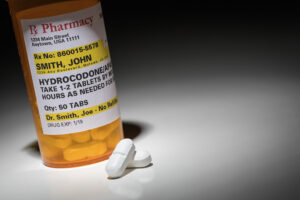 More than 30% of Americans have some form of acute or chronic pain.1 Among older adults, the prevalence of chronic pain approaches 40%.2 The extended prescription of opioids (>8 weeks) for the treatment of chronic pain presents substantial public health risks. The risks of overdose and addiction from extended opioid prescribing increases with higher doses (>100 MME) and longer durations of prescribing.3
More than 30% of Americans have some form of acute or chronic pain.1 Among older adults, the prevalence of chronic pain approaches 40%.2 The extended prescription of opioids (>8 weeks) for the treatment of chronic pain presents substantial public health risks. The risks of overdose and addiction from extended opioid prescribing increases with higher doses (>100 MME) and longer durations of prescribing.3
As the opioid epidemic continues to grow, it is no surprise that prescribers have been placed under a microscope. The DEA’s evolving policies and guidelines aim to stop illegal prescribing and dispensing practices. Federal and state regulations have increased monitoring of opioid prescribing. Unfortunately, some of the good intentions of those policies are placing legitimate prescribers in a difficult position.
Pain Management providers are feeling the most pressure to meet regulated morphine milligram equivalents (MME) limits. The CDC’s guidelines emphasize two thresholds based on data associated with risk of overdose when opioids are prescribed for pain – 50 MME/day and 90 MME/day. While some instances may justify use above these thresholds, the CDC guidance recommends avoidance of doses ≥90 MME/day.4 Legacy opioid patients who have required higher doses for longer periods of time to manage a chronic condition can easily exceed that limit.
According to the current approach provided in the CDC guidelines, calculating the total daily dose of opioids helps to identify patients that could benefit from dose reduction or tapering, thus reducing the risk of overdose.4 However, many of these patients will suffer from opioid withdrawal while attempting to taper down. The issue — it could take many months or years to reduce dosages properly, safely, and asymptomatically to acceptable levels. Therapeutic options are limited in this capacity. A rapid or sudden reduction of opioids results in severe withdrawal symptoms leading providers to choose between the patient’s comfort and the patient’s health.
S.T. Genesis can play a pivotal role in reducing withdrawal symptoms many opioid-dependent patients can face when attempting a taper or reduction strategy. The FDA-cleared device supports the reduction of opioid withdrawal symptoms by targeting the areas of the brain responsible for pain and anxiety. The noninvasive, drug-free device is easily applied to the ear by any provider and administers treatment for 5 days helping the patient during the most critical time as they reduce opioid use. The device has proven clinical efficacy in reducing opioid withdrawal symptoms by up to 93% within the first hour, most occurring within 15 minutes. Anecdotal evidence shows it helps in combination with an agonist or partial agonist induction with lower dosing and more rapid tapers, when utilized in the middle or end of a taper, and when transitioning patients from Methadone to Suboxone.
Pain Management providers are seeking new opioid reduction strategies. The neurostimulation treatment of S.T. Genesis offers an effective option for opioid withdrawal symptom management.
Sources:
1. Institute of Medicine. Relieving pain in America: a blueprint for transforming prevention, care, education and research. Washington, DC: National Academies Press, 2011.
2. Johannes CB, Le TK, Zhou X, Johnston JA, Dworkin RH. The prevalence of chronic pain in United States adults: results of an Internet-based survey. J Pain 2010;11: 1230-9.
3. Chou R, Deyo R, Devine B, Hansen R, Sullivan S, Jarvik J. The effectiveness and risks of long-term opioid treatment of chronic pain: Evidence Report/Technology Assessment. Rockville, MD: Agency for Healthcare Research and Quality, 2014. No. 218 (AHRQ publication no. 14-E005- EF).
4. Centers for Disease Control (CDC) Calculating Total Daily Dose of Opioids for Safer Dosage. Retrieved from CDC website: https://www.cdc.gov/drugoverdose/pdf/calculating_total_daily_dose-a.pdf

